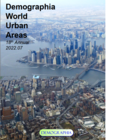An article in Salon by anti-capitalist Chris Hedges argues that our civilization is on the verge of collapse. As evidence, he points to the 65 percent decline of the population of St. Louis since 1950. read more »
Demographics
America Has An Oedipus Complex
As in Sophocles’s tragedy Oedipus Rex, we are witnessing a generational drama in which inheritors kill their proverbial father to marry their mother, in this case Mother Earth. The psychology behind this pattern is above my pay grade, but many of the richest people on the planet, and their heirs, now seem anxious to disparage the economic system that created their fortunes. read more »
Total Fertility Rate: Metros — San Francisco (Lowest) to Jacksonville (Highest)
As we previously reported, US total fertility rates have dropped markedly since 2010. The total fertility rate (TFR) is “the expected number of lifetime births per woman women given current birth rates by age.” read more »
- Login to post comments
The Unexpected Future
We are entering an unanticipated reality—an era of slow population growth and, increasingly, demographic decline that will shape our future in profound and unpredictable ways. read more »
- Login to post comments
Population and Fertility to 2100: 10 Largest Nations
The recently released United Nations World Population Prospects: 2022 forecasts a future with fewer people in 2100 than there were in 2000. read more »
- Login to post comments
Migratory Millennials - Marching from the Metropolis
As stories of new migration patterns and movement across Australia’s cities and regions abound, updated population data shows that what initially appeared to be a pandemic-induced blip is instead the beginning of a reversal of a long-term trend. read more »
- Login to post comments
Why Suburbia Will Decide the Future
Welcome to the future of American politics. The US population is changing in major ways that will likely alter the balance in politics and economics to the advantage of Republican-leaning red states, as well as suburbs and exurbs across the country. read more »
UN World Population Projections: Declines Later in the Century
Since the beginning of the 19th century, world population has skyrocketed. According to a summary of estimates by the US Census Bureau, the world population was about 970 million in 1800 (midpoint of the high and low estimate). The Census Bureau site indicates that population usually increased in previous centuries, though was at an all-time high in 1800. read more »
- Login to post comments
US Total Fertility Rates: Toward Europe?
The latest final births data (2020) from the Center for Disease Control indicates that the US total fertility rate continued to decline and has reached a record low. The total fertility rate is the number of children that the average woman has during her child-bearing years. In 2020, the US rate was 1.64, well below the 2.10 replacement rate. read more »
- Login to post comments
Demographia World Urban Areas: 2022 Released
The 2022 edition of Demographia World Urban Areas has been released, which provides revised population estimates based on the 2020 round of censuses, though some censuses have been delayed due to the pandemic (such as in India and Bangladesh). read more »





















